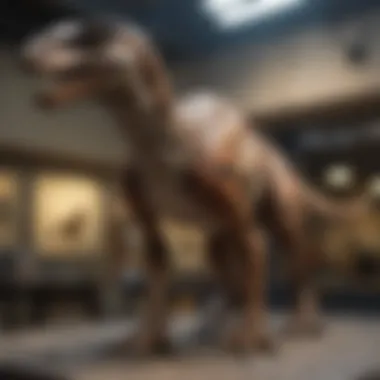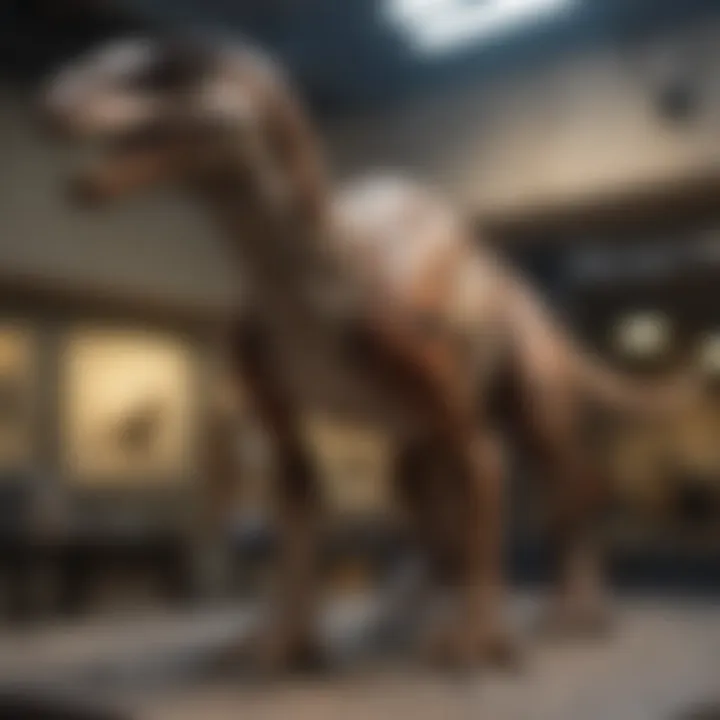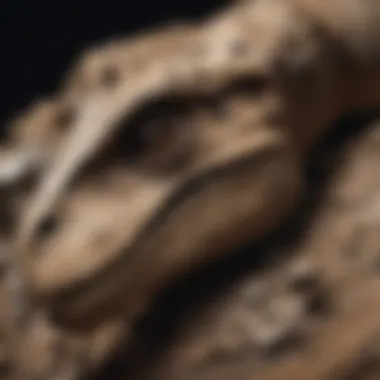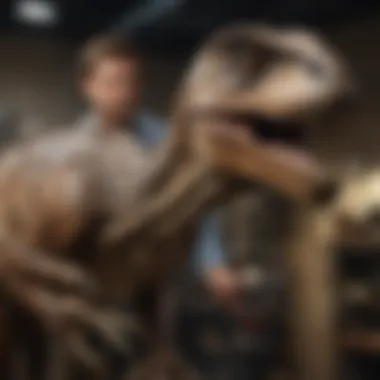Exploring the Lifesize Raptor: An In-Depth Analysis


Intro
The lifesize replicas of raptors have garnered significant interest within both the paleontological community and popular culture. These meticulously crafted representations offer a tangible connection to a time long past, awakening our curiosity about the behavior and environment of these creatures. This article aims to provide an in-depth analysis of the implications surrounding these lifelike representations, including their cultural significance, evolutionary context, and the collector's market.
In exploring this topic, we shall highlight the relevance of raptors within modern culture and the ways they have been interpreted through art and science. The complexity of such representations reflects a profound understanding not only of the physical aspects of these dinosaurs but also of the cultural and artistic lenses through which we view them. Collectors will benefit from the insights provided on how to identify and acquire authentic lifesize raptors, emphasizing the balance between aesthetic appeal and scientific representation.
Featured Collectible of the Month
Overview
This section will focus on a particular raptor collectible that exemplifies the artistry and scientific accuracy desired by enthusiasts. Each month, we will feature a collectible that stands out due to its craftsmanship or historical context, highlighting why it deserves a place in any serious collection.
Historical Significance
Understanding the historical importance of lifesize raptor replicas enhances their appeal. These collectibles serve as a reminder of the fascinating stories of discovery and reconstruction that underline our understanding of these ancient predators. The craftsmanship behind these replicas often involves collaboration between paleontologists and artists, resulting in products that tell a story as much as they depict a dinosaur.
Identification Techniques
Visual Characteristics
Accurately identifying lifesize raptors and their replicas requires keen attention to detail. Features to look for include:
- Scale: Ensure the size of the model corresponds with authentic raptor dimensions, typically ranging from 1.5 to 2.5 meters in height.
- Coloration: Many replicas utilize scientifically-informed colors that reflect current understandings of feathering and skin pigmentation.
- Pose: Raptors are often depicted in active postures, showcasing their agility and predatory behavior.
Resources for Identification
For collectors seeking further clarity on identifying raptors, several resources can provide valuable insights. Recommended websites include:
- Wikipedia - Velociraptor
- Britannica - Velociraptor
- Reddit for community discussions about collections and replica authenticity.
Collectors should always consider the source of their replicas, ensuring that they are purchasing from reputable manufacturers to guarantee accuracy and quality.
Prologue to Lifesize Raptors
Lifesize raptors intrigue both paleontologists and collectors. Their representation sheds light on our understanding of these fascinating creatures that once roamed the Earth. In this section, we will explore the importance of lifesize raptors and their implications for study and collection. By examining their definition, historical context, and the role they play in modern culture, we can appreciate the multifaceted significance of these models.
Definition and Overview
Lifesize raptors are scaled models created to depict the physical characteristics of raptor dinosaurs. Specifically, they often resemble species like Velociraptor or Utahraptor. These replicas provide a visual context that enriches our understanding of raptor biology and behavior. They are made with attention to detail, incorporating scientific data on size, anatomy, and movement, which helps enthusiasts visualize these creatures as they once existed in their natural habitats.
The lifesize aspect is crucial because it allows collectors, students, and the general public to grasp the actual dimensions and scale of raptors. This representation aids in educational settings and enhances public appreciation for paleontological studies. It also serves an aesthetic role, as many collectors admire the combination of artistry and science in these replicas.
Historical Context
The interest in raptors can be traced back to significant fossil discoveries in the late 19th and early 20th centuries. Pioneering figures like Othniel Charles Marsh and Edward Drinker Cope were instrumental in unearthing raptor fossils in North America. The emergence of these early findings stirred public fascination with dinosaurs, leading to a lasting cultural impact.
Through the decades, raptors have been a focal point in both scientific discourse and popular media. The film Jurassic Park notably popularized the image of raptors in the 1990s, merging scientific fact with imagination. This cultural phenomenon significantly affected how lifesize raptors are produced and perceived. Collectors often seek replicas that represent iconic species, blending love for paleo-science with elements of entertainment.


The Paleontological Significance of Raptors
The lifesize raptors hold an important place in the field of paleontology. Their significance extends beyond mere representation; they serve as a bridge connecting the past to the varying interests of enthusiasts today. Understanding these creatures can provide insights into their evolutionary history, their role within ecosystems, and how modern science engages with their fossilized remains.
Evolutionary Insights
Raptors are often associated with the theropod category of dinosaurs, known for their bipedal stance and sharp features. The evolutionary path of these creatures is complex. They are believed to have shared a common ancestor with modern birds, highlighting a significant moment in evolutionary history. Studies indicate that features like feathers and specialized claws were crucial for their survival and adaptation. This connection to birds has propelled ongoing research into the origins of flight.
Modern genetic studies have helped clarify the lineage of raptors, suggesting a dynamic evolution influenced by environmental factors. The attributes we see in lifesize raptors today are not mere aesthetic choices; they reflect adaptations to their surroundings.
Fossil Discoveries
Fossil finds are critical to our understanding of raptors. These discoveries are often sourced from sedimentary rock layers, where conditions allowed for preservation over millions of years. Notable sites, like the Hell Creek Formation in Montana, have yielded impressive raptor fossils, shedding light on their morphology, behavior, and habitat.
The study of these fossils has revealed much about the diversity within the raptor group. Some species were small and agile hunters, while others displayed more robust physiques, catering to different ecological niches. The robust fossil record allows researchers to track changes in the raptor lineage over time, marking moments of biodiversity and extinction.
"Fossils are the key to unlocking secrets of the past, helping us understand the nuances of evolutionary processes and ecological interactions."
Raptors in the Ecosystem
Raptors occupied significant ecological roles during their time on Earth. As predators, they contributed to the regulation of prey populations, maintaining balance within their ecosystems. By studying modern birds of prey, scientists infer the dietary habits and hunting behaviors that raptors might have exhibited.
These creatures likely interacted with various other species, influencing biodiversity and ecological dynamics. Their presence in specific habitats indicates the complex food webs of the Mesozoic era. By examining these interactions, we gain valuable knowledge about the ecosystems in which raptors thrived.
Through this analysis, it becomes evident that the lifesize representations we see today are not only artistic endeavors but also crucial educational tools. They help communicate the rich story of raptors, nurturing a deeper appreciation for these elliptical creatures of the past.
Cultural Representations of Raptors
Cultural representations of raptors provide a lens through which we can understand the multifaceted roles these iconic dinosaurs play in society. Their depictions in various media reflect not only artistic creativity but also collective human fascination with prehistoric life. This section will examine some key aspects relevant to the cultural significance of raptors, with a focus on media portrayals, artistic interpretations, and the educational roles they assume in museums. Each of these facets contributes to an enhanced understanding and appreciation of raptors, shaping how they are perceived in both popular culture and educational environments.
Media Portrayals
Media has been pivotal in shaping public perception of raptors. From classic films like Jurassic Park to documentaries aired by National Geographic, the portrayal of these creatures has often blended fact with fiction. Such representations not only entertain but also inform viewers about the biology and behavior of these ancient creatures.
- Film: The cinematic adaptation of raptors has ranged from terrifying predators to misunderstood creatures. This duality highlights our evolving understanding of dinosaurs.
- Television: Documentaries provide details on paleontological discoveries, while fictional shows engage audiences with dramatized anthropomorphized raptors.
These portrayals influence public interests in paleontology, potentially inspiring new generations to explore the field further.
Artistic Interpretations
Artistic interpretations of raptors span various mediums, from sculptures to paintings. Artists engage with the challenge of depicting these creatures in ways that balance scientific accuracy with creative expression. The raptors are often reimagined, bringing to life their physical forms and behaviors based on fossil evidence. This process not only stimulates viewer interest but also promotes dialogue between art and science. Works of art serve as educational tools, inviting people to consider both the aesthetics of the raptors and the realities of their existence.
- Sculptures: Lifesize models showcased in various exhibitions can evoke strong emotional responses and greater appreciation for these animals.
- Illustrations: Detailed illustrations in books and articles help bridge the gap between science and art, providing insights into how raptors may have looked and behaved.
These artistic expressions highlight the impact of raptors on cultural narratives, allowing society to visualize and contemplate these magnificent creatures.
Educational Role in Museums
Museums play a critical role in educating the public about raptors. Through lifesize replicas, scientific exhibits, and interactive displays, museums offer engaging environments for learning. Visitors can see accurate representations of raptor skeletons alongside comprehensive information about their habitats and diets. This connection between display and knowledge fosters a deeper understanding of these dinosaurs.


- Fossil Displays: Fossils displayed in museums provide tangible evidence of raptors and contextualize their place in evolution.
- Interactive Exhibits: Many institutions have incorporated technology, allowing visitors to explore raptors’ worlds through virtual exhibits.
"Museums serve as the bridge between the past and present, allowing a direct connection with the history of life on Earth."
The Science Behind Lifesize Replicas
The creation of lifesize raptor replicas is a complex process that merges art, science, and technology. The significance of this topic extends beyond mere aesthetics; it embodies the dedication to preserving scientific truths while delivering visual impact. Understanding the mechanisms behind these replicas is crucial as it informs collectors about quality, authenticity, and care practices. Replicas play a dual role: as educational tools and as artworks that honor the magnificence of these ancient creatures. Their design must balance accuracy with artistic interpretation, enabling a deeper appreciation of raptors within both paleontological research and cultural contexts.
Technology in Replication
The field of replication technology has evolved significantly. Today, various methods are employed to create lifesize dinosaur replicas that can pass as realistic representations of their ancient counterparts. One critical technology is 3D printing. This method allows for high precision, as data gathered from fossil records can be translated into accurate digital models. The process involves scanning fossils, which generates data points that create a three-dimensional view of the bones. Subsequently, a 3D printer can produce detailed models with intricate textures.
Additionally, computer-generated imagery (CGI) enriches the replication process. Artists use CGI for visualizing and animating raptors based on paleontological findings. This approach not only aids in the creation of accurate replicas, but it also helps to engage audiences in museums or educational settings.
Moreover, advancements in materials like silicone and polyurethane offer realistic textures while maintaining lightweight and durable constructs. This technology also enables the addition of lifelike features, enhancing the overall viewing experience.
Materials Used in Construction
The choice of materials in the construction of lifesize raptors is vital for both authenticity and practical considerations. Artists and manufacturers use a combination of polymer resin, fiberglass, and foam.
- Polymer resin: This material provides rigidity and ensures the detailing is reflective of actual dinosaur textures. Its application varies from structural elements to skin details.
- Fiberglass: Known for its strength and flexibility, fiberglass allows for larger constructs to maintain structural integrity without compromising design. Besides that, it provides ease of transport for collectors as well.
- Foam: Used primarily in internal support, it keeps the cost manageable while maintaining the weight of the replica. Foam allows for intricate details without added heft.
It is essential for collectors to understand these materials as they influence the longevity and care of the replicas. Proper care for materials can extend the life of lifesize raptors, ensuring they remain impactful representations of their real-life counterparts.
Collecting Lifesize Raptors
Collecting lifesize raptors presents a fascinating convergence of art, science, and history. For hobbyists and serious collectors alike, these replicas serve as more than mere decor; they encapsulate an era that excites the imagination. Understanding the nuances of this field is critical for ambitious collectors seeking to navigate both opportunities and challenges associated with acquiring these impressive pieces.
Market Trends and Value
The market for lifesize raptors has seen fluctuating trends over recent years. These trends reflect not just the demand for such collectibles but also influence pricing and availability. Seasonal exhibitions, auctions, and specialized shows contribute to market dynamics.
- Increased Interest: Interest in paleontology has surged, fueled by media portrayals and documentaries. This uptick encourages collectors to seek out lifelike representations.
- Valuation Factors: Factors like age, realism, and craftsmanship affect the market value of a replica. High-quality work, such as that from well-known artists or manufacturers, commands higher prices.
- Resale Potential: Some collectors invest with the view of resale, banking on the appreciation of their replicas. Understanding when to buy and sell is essential.
As a result, staying informed about market trends, through resources like industry publications or online forums, can greatly benefit anyone looking to invest in lifesize raptors.
Source and Authenticity
For collectors, sourcing lifesize raptors authentically can be a rigorous process. The integrity of a collection hinges not only on the physical aspect of replicas but also on their provenance. Here are important factors to consider:
- Reputable Sellers: Deal with well-established companies known for quality and ethical practices. This reduces the risk of acquiring fakes.
- Documentation: Always request documentation, if available. Certificates of authenticity can add significant value to a piece and protect against counterfeits.
- Ethical Sourcing: Ensuring that replicas are sourced ethically assures collectors that their purchases contribute to responsible practices. This is especially relevant for individuals who support sustainability.
Care and Preservation of Replicas
Once acquired, proper care and preservation of lifesize raptors is vital. These delicate structures can deteriorate if not maintained appropriately. Here are key strategies:
- Routine Maintenance: Regular cleaning is critical. Use microfiber cloths and gentle cleaning agents to avoid damaging the surface.
- Environmental Control: Protect against extreme temperatures and humidity, which can warp and degrade materials. Ideally, keep them in climate-controlled environments.
- Display Considerations: Utilize UV-protective glass for displaying your raptors to prevent fading. Avoid direct sunlight, which can damage colors and materials over time.


"Collecting lifesize raptors is an engaging blend of passion and responsibility. Each piece is a testament not just to art, but to science and history."
By understanding the market, verifying sources, and committing to preservation efforts, collectors can enjoy their lifesize raptors for years to come. This approach cultivates not only a beautiful collection but also a deeper appreciation for these magnificent creatures.
Ethical Considerations in Collecting
Ethical considerations play a significant role in the collecting of lifesize raptors. Awareness of the implications of collecting can enhance the integrity of this pursuit. Collectors not only seek aesthetic appeal but also bear the responsibility to respect the origins and contexts of the items they acquire. Recognizing the ethical dimensions enhances the appreciation for the craftsmanship of lifesize raptors while ensuring that the practices adopted do not harm the global heritage.
Legal Aspects of Collecting
Understanding legal aspects surrounding lifesize raptors is vital for collectors. Each country has specific laws governing the collection and trade of artifacts, particularly those related to paleontology. It is essential for collectors to inform themselves about the legality of their purchases, as acquiring replicas from unauthorized sources may result in severe penalties. Many lifesize raptors are carved from materials that fall under international protection, highlighting the need for collectors to verify the provenance of their items.
In summary, consider the following when collecting:
- Research the laws applicable in your jurisdiction.
- Request certificates of authenticity or proof of origin from sellers.
- Support licensed vendors who follow ethical collecting practices.
By adhering to legal regulations, collectors contribute to the preservation of paleontological integrity and foster a community that values responsibility in acquisition.
Sustainability Practices
Sustainability practices form another critical component of ethical considerations in collecting lifesize raptors. As interest in these replicas grows, so too does the demand for materials used in their construction. As a result, collectors should consider the environmental impact of their purchases. It is advisable to seek out vendors who prioritize sustainable sourcing of materials. This not only supports ethical practices but also encourages the market to adapt to more environmentally friendly alternatives.
Incorporating sustainability into the collecting process can manifest in various ways:
- Choosing Eco-Friendly Materials: Opt for replicas made from recycled or sustainably harvested materials.
- Minimizing Waste: Support manufacturers who create products with minimal packaging and waste.
- Emphasizing Conservation: Consider supporting artists or brands that donate a portion of their sales to conservation efforts.
Adopting these practices can be beneficial for both collectors and the environment, ensuring that the legacy of lifesize raptors is preserved for future generations.
Collecting should not merely be about possession, but also about connection to the broader ecosystem of knowledge and preservation.
Epilogue and Future Directions
In the exploration of lifesize raptors, it becomes evident that the subject matter encapsulates a intersection between scientific research and cultural appreciation. The relevance of discussing the future directions in this field derives from the ongoing quest for knowledge in paleontology, along with the evolving technologies that can enhance our understanding and representation of these prehistoric creatures.
Ongoing Research in Paleontology
Research in paleontology is continuously progressing, focusing on various aspects of raptor biology and behavior. A significant part of this research is centered around new fossil discoveries, which often provide fresh insights into the evolutionary bridges connecting modern birds to their dinosaur ancestors. Notable studies have emerged recently, enhancing the understanding of raptor physiology and their ecological roles during the Mesozoic era.
Scientists have utilized advanced techniques like CT scanning and isotopic analysis. This enables them to study the internal structures of fossils without damaging them, revealing critical information about the diets and habitats of raptors. As new findings are published, they reshape the narrative surrounding these creatures. Ongoing research not only serves to enrich our knowledge of raptors but also engages a broader public interest in paleontology.
Innovations in Representation
The innovation in the representation of lifesize raptors significantly influences how we perceive these ancient beings. Technologies such as 3D printing and augmented reality are pushing the boundaries of how collections are displayed and how educational content is delivered. For instance, 3D models of raptors can be used in museums, allowing visitors to interact with detailed representations that were not possible before.
Moreover, these innovations foster a deeper connection between the audience and the subject. They can experience lifelike movements and visualizations, understanding raptors not just as static displays but as active components of a vibrant ecosystem. The use of biotechnological advancements to mimic lifelike appearances also enriches educational programs, making the learning experience more engaging for all ages.
Encouraging Collecting and Preservation
Collecting lifesize replicas of raptors serves multiple purposes—both aesthetic and educational. However, it is crucial to approach this practice with sensitivity towards the ethical considerations surrounding the acquisition and display of replicas. Encouraging responsible collecting emphasizes the importance of authenticity and sustainability. Collectors are urged to ensure that their sources adhere to both legal standards and ethical norms.
Preserving these replicas effectively is another essential element. Proper care extends their lifespan and maintains their educational value. Collectors should be informed about various preservation techniques, including environmental controls such as humidity and temperature, which can affect the integrity of materials used in these models.
Future directions in collecting also reflect a growing trend toward collaborative efforts between collectors and institutions, resulting in greater accessibility to lifesize models for educational purposes.
Through scrutinizing lifesize raptors, we not only uphold the scientific legacy of these magnificent creatures but also empower ourselves as stewards of their representations in modern society.



